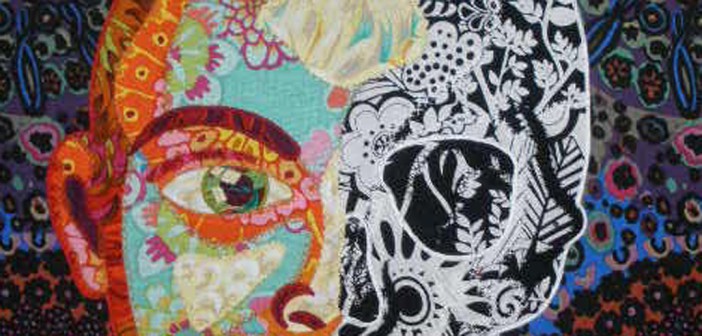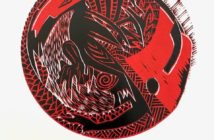Embroiderer Jo Dixey may have been formally educated at the Royal School of Needlework but it is her inherent talent, creativity and love of her craft that produces the unique stitch/embroidery that is such an integral part of her life.
It was totally serendipitous that I met Jo Dixey, Helensville-based embroiderer and stitch artist. I was on one of my regular visits to the Tauranga Art Gallery when I noticed that the Education Room, usually peopled by children or FOG meetings was crowded with women working with sweatshop intensity. On a table and visible through the glass doors were a series of images: faces – some dark brown, some black against off-white or khaki backgrounds. Childlike I pressed my face up against the glass to get a better look. I went back a second time and on this occasion an English-voiced young woman invited me in to have a look at what was happening.
It was a specialist embroidery workshop tutored by Jo with participants from Rotorua and Hamilton as well as local embroiderers such as Linda Inglis. The embroiderers were learning to embroider faces. I was allowed to walk around the students and look at their work. It was fascinating to see even in the confines of the moderately sized room the difference in style, colour and approach within the wider tutorial topic.
I’m of the age where , irrespective of academic and professional aspiration, “little girls” were taught to knit, sew their own clothes and to embroider. Somewhere tucked away I have a garish and multi-coloured “traycloth” that I sat still long enough to finish. I don’t know what happened to the pair of pillow cases I embroidered with large sixties-style daisies. I don’t think it was this minor background in stitch that made me peer repeatedly at the examples of Jo’s craft (the faces I had seen on the table). They were so finely done that I couldn’t work out whether they were painted or computer generated. I decided I and ARTbop readers should know more about this outstanding exponent of craft and creativity.
Jo was particularly generous with her time and I was able to telephone interview her from Tauranga. I immediately wanted to know how she had become a professional embroiderer and embroidery tutor. Jo’s family were creative; women who were knitters, sewers, quilters and stitchers. Interestingly a Grandfather had as “his winter past-time” rugmaking. These were to his own design and “there was always a rug on the go.” Jo was only 9 years old when she bought her first sewing machine. Turning to stitching, Jo tells me she knew as a teenager that was what she was going to do.
Life in England for Jo was centred round “a tiny village” an hour from London. It was a village where many felt that the journey to and experience of London were unnecessary. Jo’s family had always let her as a teenager travel up to London to visit museums and buy textiles. It was only later Jo realised how atypical of the times and her environment that was.
I love the story Jo tells me of attending a major Knitting and Stitching Show in England and quite by chance finding the information brochure for the Royal School of Needlework in London and deciding there and then that she was going to be an apprentice embroiderer. It was the same day she met her creative hero Kaffe Fassett Despite her decision and commitment to a career path, Jo stayed at school until she was 18 years old and completed her A levels. She was accepted as an apprentice “it was meant to be.” Jo went off to London with the total support of her family despite the village comments of “ how can you let her go”
It was a three-year apprenticeship – two years classroom work and training learning a huge variety of techniques. The third year was in the workroom. It was everything – restoring the embroidery on curtains from a stately home; embroidering names on family christening robes; embroidering for fashion designers – a huge variety and fantastic training. During her time at the Royal School Jo was exposed to the work and working style of freelance embroiderers creating art as well as undertaking commission work for the School’s workroom. Early on Jo decided she was going to follow this particular pathway and create art with stitch.
So what is Jo now? She is a self-employed professional embroiderer with a huge catalogue of techniques. Much of Jo’s work is for churches such as repairing or creating new church garments. Jo stitched the graduation banners for Auckland University. A designer may want a heavily embroidered bodice for a wedding dress. “Anything really.” Because of her formal professional training and expertise Jo is well-known around New Zealand and her skills much sought after. Jo is also a much sought after tutor and teacher; she says she believes she is a “gentle teacher” as she is often taking people far out of their creative comfort zones and established techniques. Jo tells me she finds her work can be cyclical – sometimes it is focused on teaching while at other times the focus is commission embroidery. Whatever it is though, she’s busy all the time.
Then there is her unique creative and exhibition work. Her work is art with stitch. Jo says she was never going to be stitching trees and flowers – Jo loves stitching faces. Jo discloses that the subject matter of her work may not always make the viewer feel comfortable or be exactly what they would have expected.
Jo says she needs to stitch; she loves the motion of stitching; she loves the whole process of stitching. “Something about me needs to create.” She says “I’m so lucky, I feel lucky. Every day I make a living at something I love.” I ask if the house was on fire what would you save? “I’d pick up my needles, my thread and my scissors then I could make anything”.
Having pried from Jo that she’s in New Zealand “because it’s better here” and “her husband is a New Zealander” I ask what opportunities there are for young New Zealand embroiderers to achieve a formal embroidery training and qualification. It seems the closest formal training would be a textiles course qualification then on to an embroidery guild. This would however now be within the framework of UK government cuts to degrees and qualifications perceived as craft based rather than art based. Jo says even in her early years you had to be “driven” to pursue the craft professionally.
Jo also mentions a random book read “The Friday Night Knitting Club” and quotes “…in a society where you don’t need handmade anything is exactly when you need handmade everything…” I think here in New Zealand of the resurgence of traditional Maori weaving and its development into contemporary forms and styles. As the Rosemary McLeod exhibition “With Bold Needle & Thread” showed, there is an innate need to create and embellish whether its street graffiti or embroidery.
New Zealand is particularly lucky to have acquired such a talented and articulate creative.
Jo has a very readable blog dixeysoul.blogspot.co.nz If you would like to contact Jo Dixey her email address is dixdean@clear.net.nz
Rosemary Balu. Rosemary is a regular contributor to ARTbop and is the founding and current Editor of ARTbop.
Note: Tauranga Embroiderers’ Guild is hosting the ANZAC Waikato/Bay of Plenty Embroiderers’ Exhibition “Remembering ANZAC in stitch 1915 – 215” It will be held at Baycourt Community and Arts Center, Durham Street, Tauranga from Wednesday 13th May to Sunday 17th May 2015.





